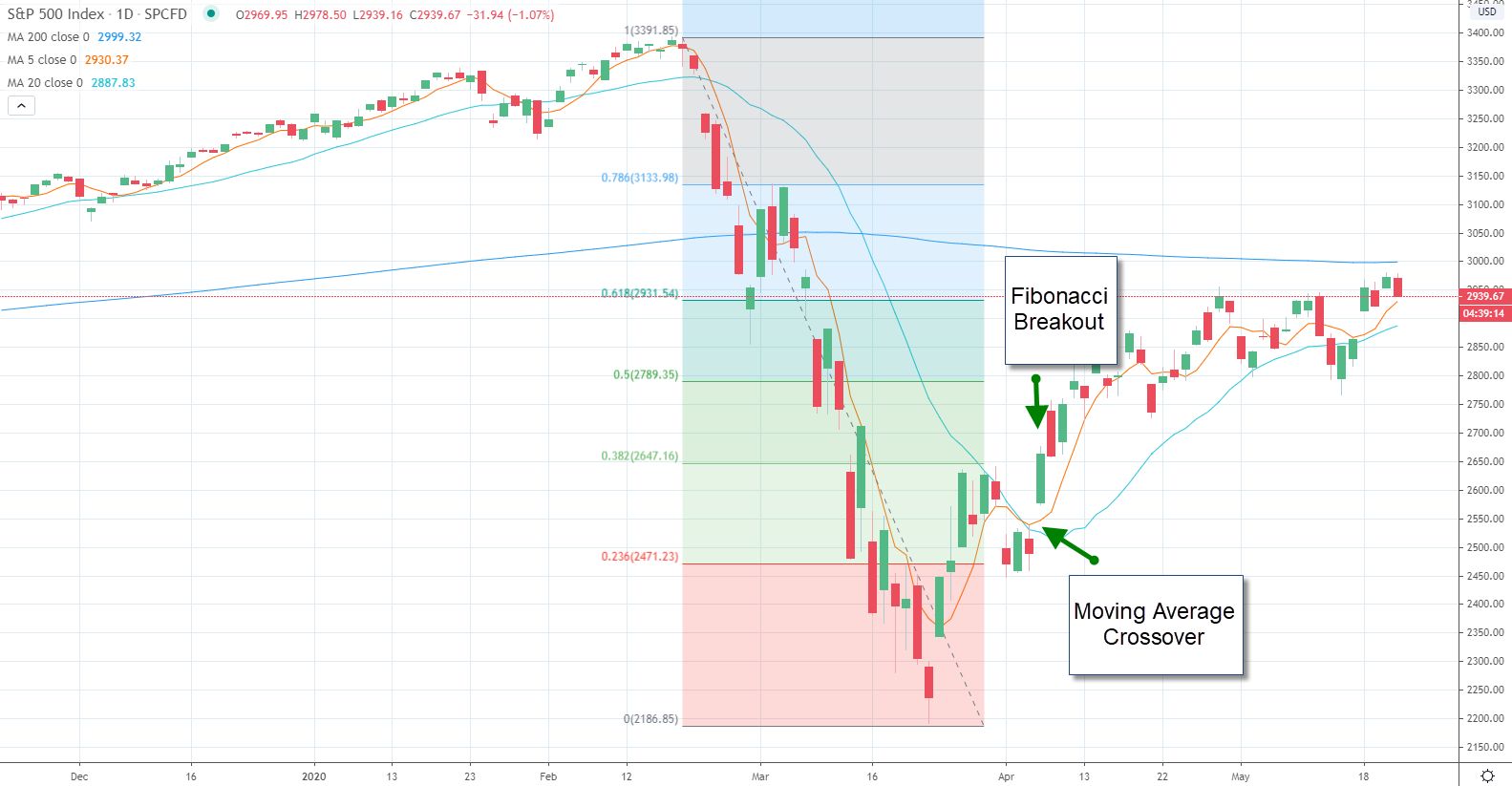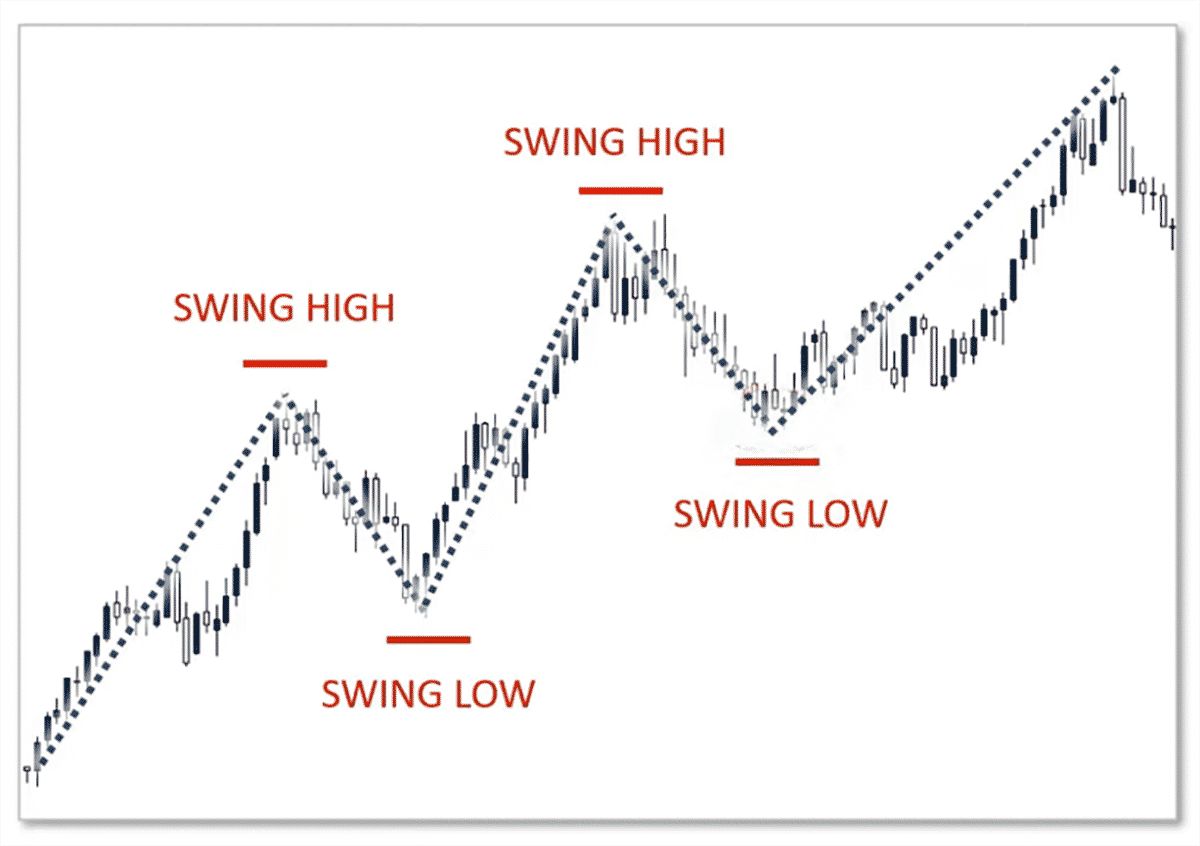Introduction
Welcome to the world of swing trading, where traders aim to capture short-term gains in the stock market by taking advantage of price fluctuations. Swing trading is a popular trading strategy that involves holding positions for a few days to several weeks, with the goal of profiting from the price movements that occur within those timeframes.
Unlike day trading, which requires constant monitoring and quick decision-making, swing trading provides a more relaxed approach for individuals who don’t have the luxury of dedicating their entire day to trading. With swing trading, traders can still actively participate in the market while keeping their day jobs or other commitments.
Swing trading focuses on capturing shorter-term price trends within the broader market. Instead of trying to predict the long-term prospects of a company or its stock, swing traders aim to profit from the intermediate price movements that occur due to various market factors, such as news releases, industry trends, and technical patterns.
In this guide, we will explore the key factors to consider before engaging in swing trading, the technical and fundamental analysis tools that can help identify potential stocks, strategies for setting up entry and exit points, risk management techniques, and the process of developing a swing trading strategy.
While swing trading can offer significant profit potential, it’s important to note that it also involves risks. The stock market can be unpredictable, and swings in price can result in losses if not managed properly. Therefore, it’s crucial to have a solid understanding of swing trading techniques, as well as the discipline and patience required to execute trades effectively.
Whether you’re a beginner looking to navigate the world of swing trading or an experienced trader seeking to enhance your skills, this guide will provide you with valuable insights and strategies to help you find stocks for swing trading. So, let’s dive in and explore the fascinating world of swing trading strategies!
Understanding Swing Trading
Swing trading is a trading strategy that aims to capture short-term price movements in the market. Unlike long-term investing, which focuses on holding stocks for months or years, swing traders seek to profit from the price fluctuations that occur over a shorter time frame.
Swing traders take advantage of price swings, or “swings,” which can occur within an uptrend or downtrend. An uptrend refers to a series of higher highs and higher lows, indicating that the stock’s price is moving upward. Conversely, a downtrend is marked by lower highs and lower lows, indicating a downward price movement.
The key principle of swing trading is to buy during a price dip in an uptrend or sell during a price rally in a downtrend. This allows traders to enter a position at a more favorable price and capture potential gains as the price swings back in the desired direction.
Swing traders typically rely on technical analysis to identify potential swing trading opportunities. They use various technical indicators, chart patterns, and trend analysis tools to assess the strength of a price trend and determine potential entry and exit points. By analyzing historical price data and patterns, swing traders aim to anticipate future price movements and profit from them.
It’s important to note that swing trading is different from day trading and long-term investing. While day traders aim to close all their positions by the end of the trading day, swing traders hold their positions for a few days to several weeks. This gives them more flexibility and allows them to capture larger price movements compared to day traders.
Furthermore, swing trading focuses on capturing shorter-term trends within the broader market. Swing traders do not concern themselves with the overall fundamentals of a company or its long-term prospects. Instead, they focus on price action and technical indicators to identify potential entry and exit points.
Overall, swing trading offers traders the opportunity to actively participate in the market and potentially generate profits from short-term price movements. However, it requires discipline, patience, and a thorough understanding of technical analysis. In the next sections, we will explore the factors to consider before swing trading, technical analysis tools, risk management strategies, and more to help you become a successful swing trader.
Factors to Consider Before Swing Trading
Before diving into swing trading, it’s important to consider several factors that can greatly impact your success as a swing trader. By carefully evaluating these factors, you can make informed decisions and increase your chances of profitable trades.
1. Time Commitment: Swing trading requires a time commitment for monitoring the market, analyzing charts, and executing trades. Unlike long-term investing, which may only require periodic evaluations, swing trading requires more frequent attention, especially during market hours. Assess your availability and ensure that you have sufficient time to dedicate to swing trading.
2. Risk Tolerance: As with any form of trading, swing trading involves risks. Prices can change rapidly, and losses are possible. It’s essential to assess your risk tolerance and determine how much capital you’re willing to risk. Establishing a risk management strategy is crucial to protect your trading account and minimize potential losses.
3. Trading Capital: Consider your trading capital, which is the amount of money you have available for swing trading. Having an adequate amount of trading capital is important to execute trades and take advantage of potential opportunities. Determine the capital that you’re willing to allocate to swing trading and ensure it’s separate from your living expenses and other financial obligations.
4. Trading Tools and Platforms: Familiarize yourself with the trading tools and platforms you’ll be using for swing trading. Choose a reliable and user-friendly trading platform that provides the necessary technical analysis tools, real-time data, and order execution capabilities. Having access to reliable and accurate market information is crucial for making informed trading decisions.
5. Education and Knowledge: Swing trading involves a combination of technical analysis and market understanding. Take the time to educate yourself about technical indicators, chart patterns, and other tools used in swing trading. Stay updated on market news and trends, understand how different factors can influence stock prices, and continuously improve your trading skills and knowledge.
6. Emotional Discipline: Successful swing traders possess emotional discipline. They stick to their trading strategies and avoid making impulsive decisions based on emotions. Develop a trading plan, define your entry and exit criteria, and stick to them. Embrace a rational and disciplined approach to trading, which can help prevent costly mistakes.
7. Market Conditions: Consider the current market conditions and overall market trends. Swing trading strategies may work better in certain market environments, such as trending markets or markets with volatility. Assess whether the market conditions align with your chosen swing trading strategy and adapt as necessary.
By carefully considering these factors, you can enter into swing trading with a clear understanding of your goals, risk tolerance, and market conditions. This will help you make informed decisions and increase your chances of success as a swing trader. In the next sections, we will delve deeper into technical and fundamental analysis tools, as well as strategies for identifying potential swing trading stocks.
Technical Analysis Tools for Identifying Potential Stocks
Technical analysis plays a crucial role in swing trading, as it helps traders identify and analyze price patterns, trends, and indicators to make informed trading decisions. Here are some key technical analysis tools that can aid in identifying potential swing trading stocks:
1. Candlestick Charts: Candlestick charts are a popular tool used by swing traders to analyze price patterns. Candlestick charts provide valuable information about the opening, closing, high, and low prices of a stock over a specific period. Traders look for patterns, such as doji, hammer, or engulfing candles, to identify potential reversals or continuation patterns.
2. Moving Averages: Moving averages are widely used in swing trading to smooth out price data and identify trends. The most commonly used moving averages are the 50-day and 200-day moving averages. Traders observe the crossover of these moving averages, as well as the relationship between the stock’s price and the moving averages, to determine potential entry and exit points.
3. Relative Strength Index (RSI): The RSI is a momentum oscillator that measures the speed and change of price movements. Swing traders use the RSI to identify overbought or oversold conditions in a stock’s price. A reading above 70 indicates overbought, while a reading below 30 indicates oversold. These levels can signal potential reversals or continuation of a trend.
4. Bollinger Bands: Bollinger Bands consist of a middle band (usually a simple moving average) and upper and lower bands that represent standard deviations from the moving average. These bands can help swing traders identify volatility and potential price reversals. When the price moves toward the upper band, it may indicate an overbought condition, while a move toward the lower band may suggest an oversold condition.
5. Volume Analysis: Analyzing volume is crucial for swing traders, as it provides insights into the strength of price movements. An increase in volume during a price breakout or reversal can indicate the presence of strong buying or selling pressure. Traders often look for volume confirmation to validate their trading decisions.
6. Support and Resistance Levels: Support and resistance levels are significant price levels where a stock’s price often reacts or reverses. Swing traders analyze these levels to identify potential entry and exit points. When a stock’s price breaks above a resistance level, it may indicate a bullish signal. Conversely, a break below a support level may signal a bearish signal.
7. Trend Lines: Trend lines are drawn on a stock’s price chart to identify the direction of the trend. Swing traders use trend lines to confirm the prevailing trend and anticipate potential trend reversals. A break above or below a trend line can provide valuable trading signals.
These technical analysis tools and indicators are just a few examples of what swing traders use to identify potential stocks for swing trading. It’s important to note that no single indicator is foolproof, and it’s often best to combine multiple indicators and analysis techniques to increase the accuracy of your trading decisions.
In the next section, we will explore the role of fundamental analysis in swing trading and how it can complement technical analysis in identifying potential swing trading stocks.
Fundamental Analysis for Swing Trading
While technical analysis is a primary tool for swing traders, fundamental analysis can provide valuable insights into the underlying value and prospects of a company. Fundamental analysis involves evaluating the financial health, market position, and growth potential of a company to assess its potential for swing trading. Here are some key aspects of fundamental analysis to consider:
1. Earnings Reports: Earnings reports provide valuable information about a company’s financial performance, including revenue, earnings, and profit margins. Swing traders analyze these reports to assess the overall health of the company and any potential impact on its stock price. Positive earnings surprises or strong earnings growth can indicate potential swing trading opportunities.
2. Industry and Market Trends: Understanding the broader industry and market trends can help swing traders identify potential opportunities and assess the growth potential of a company. Analyze industry reports, news, and market trends to stay informed about factors that can influence the stock prices of companies within a particular sector.
3. Financial Ratios: Financial ratios, such as price-to-earnings (P/E) ratio, price-to-sales ratio, and return on equity (ROE), can provide insights into the valuation and profitability of a company. Swing traders consider these ratios to evaluate whether a stock is overvalued or undervalued relative to its peers and the broader market.
4. Management and Leadership: The leadership team and management of a company play a crucial role in its success. Assess the experience, track record, and credibility of the management team to understand their ability to execute the company’s strategic plans. Positive developments in leadership or management changes can influence a company’s stock price and present swing trading opportunities.
5. News Events and Market Sentiment: Stay informed about news events and market sentiment that can impact the stock prices. Swing traders monitor news releases, corporate announcements, and economic data that can trigger significant price movements. Positive or negative news events can create swing trading opportunities if they influence market sentiment or change the perception of a company’s prospects.
6. Analyst Recommendations: Consider the recommendations and ratings from analysts who cover the company. Analyst recommendations can influence market sentiment and the stock price. Swing traders may consider analyst reports and forecasts to gain insights into the potential future performance of a stock.
7. Competitive Landscape: Assess the competitive landscape of the company’s industry and its market position. Evaluate factors such as market share, competitive advantages, and barriers to entry. Understanding the competitive dynamics can help identify stocks with strong growth potential for swing trading.
It’s important to note that while fundamental analysis provides valuable insights, swing traders primarily focus on shorter-term price movements. Therefore, the combination of fundamental analysis with technical analysis is often used to make well-informed trading decisions.
In the next sections, we will explore how to identify trends and reversals, set up entry and exit points, and develop a swing trading strategy to enhance your success as a swing trader.
Identifying Trends and Reversals
Identifying trends and potential reversals is a crucial aspect of swing trading. By understanding the direction of the price trend and anticipating reversal points, swing traders can enter and exit positions more effectively. Here are some key methods for identifying trends and reversals:
1. Trend Lines: Trend lines are drawn on a price chart to identify the direction of the prevailing trend. An uptrend is marked by a series of higher highs and higher lows, while a downtrend consists of lower highs and lower lows. Swing traders draw trend lines by connecting the significant high points or low points on the chart. A break above or below the trend line can indicate a potential trend reversal.
2. Moving Averages: Moving averages are widely used indicators for identifying trends. The 50-day and 200-day moving averages are often regarded as key levels of support and resistance. When the price is consistently trading above the moving averages, it suggests an uptrend, while trading below signals a downtrend. Crossovers of different moving averages can also indicate potential trend reversals.
3. Price Patterns: Price patterns can provide valuable insights into potential trends and reversals. Patterns such as higher high and higher low (HHHL) and lower high and lower low (LHLL) can indicate an uptrend or downtrend, respectively. Chart patterns like head and shoulders, double tops, and double bottoms can also signal potential trend reversals.
4. Oscillators: Oscillators are technical indicators that can help identify overbought or oversold conditions in the market, which may signal potential reversals. Popular oscillators used by swing traders include the Relative Strength Index (RSI), Stochastic Oscillator, and Moving Average Convergence Divergence (MACD).
5. Volume Analysis: Analyzing volume alongside price movements is crucial for confirming trends and potential reversals. Increasing volume during a trend can indicate strength and confirm the direction. Conversely, a decrease in volume during a trend may signal a weakening trend or a potential reversal.
6. Breakouts and Pullbacks: Keeping an eye on breakouts and pullbacks can help identify trends and potential reversals. Breakouts occur when the price moves above a significant level of resistance or below a level of support, indicating a potential trend continuation. Pullbacks are temporary price retracements within a trend and can present opportunities to enter a position at a more favorable price.
7. News Catalysts: News events and market catalysts can also influence trends and reversals. Positive or negative news releases, such as earnings reports, economic data, or industry-related announcements, can trigger significant price movements and potential trend shifts.
Remember, it’s important to confirm potential trends and reversals using multiple indicators and analysis techniques. Using a combination of technical analysis tools, along with proper risk management strategies, can help increase the effectiveness of your swing trading decisions.
In the next section, we will discuss setting up entry and exit points and explore risk management strategies for successful swing trading.
Setting Up Entry and Exit Points
Setting up entry and exit points is a critical aspect of successful swing trading. By establishing well-defined entry and exit points, swing traders can effectively manage their risk and maximize their potential profits. Here are some key considerations for setting up entry and exit points:
1. Entry Points: When determining entry points, swing traders typically look for signals that indicate a potential trend continuation or reversal. These signals can include breakouts from chart patterns, moving average crossovers, or confirmation from oscillators. The goal is to enter a position when the odds of the desired price movement are in your favor.
2. Confirmation: It’s important to confirm potential entry points with multiple indicators or analysis techniques. This can help filter out false signals and increase the probability of successful trades. For example, if a stock breaks above a resistance level, you may want to confirm the breakout with an increase in volume or a bullish candlestick pattern.
3. Stop Loss Levels: Setting appropriate stop loss levels is crucial for managing risk and protecting against significant losses. A stop loss is a predetermined price at which you will exit the trade if the price moves against your position. The stop loss level should be placed below support levels or above resistance levels, taking into account the stock’s volatility and your risk tolerance.
4. Profit Targets: Setting profit targets allows you to take profits when the price reaches a predetermined level. Swing traders often use key technical levels, such as previous highs or lows, or Fibonacci retracement levels, to identify potential profit targets. It’s important to have a target in mind when entering a trade to ensure you have a clear plan for when to take profits.
5. Trailing Stops: Trailing stops are stop loss orders that are adjusted as the price moves in your favor. They allow you to protect profits and potentially capture more gains if the price continues to move in the desired direction. Trailing stops can be based on a fixed percentage or a specific indicator, such as a moving average.
6. Risk-to-Reward Ratio: Consider the risk-to-reward ratio when setting up entry and exit points. This ratio compares the potential gain of a trade to the potential loss, helping you assess whether the trade is worth taking. Swing traders typically seek trades with a favorable risk-to-reward ratio, aiming for higher potential rewards relative to the risk involved.
7. Flexibility: Be prepared to adjust your entry and exit points if new information or market conditions arise. The market can be unpredictable, so it’s important to remain flexible and adapt your trading plan as needed. Be open to exiting a trade if it no longer aligns with your initial analysis or if there are changes in the overall market environment.
Remember, successful swing trading involves a combination of technical analysis, risk management, and an adaptable mindset. By carefully setting up your entry and exit points and sticking to your trading plan, you can improve your chances of profitable trades and long-term success as a swing trader.
In the next section, we will discuss risk management strategies for swing traders, which are crucial for protecting your capital and minimizing potential losses.
Risk Management Strategies for Swing Trading
Risk management is a crucial aspect of swing trading that helps protect your capital and minimize potential losses. Implementing effective risk management strategies is essential for long-term success as a swing trader. Here are some key risk management strategies to consider:
1. Position Sizing: Proper position sizing is vital to limit the amount of capital you risk on each trade. Determine the maximum percentage of your trading capital you are willing to risk per trade. This percentage should be based on your risk tolerance and overall trading strategy. By controlling your position size, you ensure that no single trade can significantly impact your overall trading account.
2. Stop Loss Orders: Implementing stop loss orders is essential for managing risk. A stop loss is a predetermined price level at which you will exit a trade if the price moves against you. Set your stop loss level based on technical indicators, support and resistance levels, or market volatility. Ensure that your stop loss is placed at a level that protects your capital while still giving the trade enough room to breathe.
3. Risk-to-Reward Ratio: Assess the risk-to-reward ratio for each trade before entering a position. The risk-to-reward ratio compares the potential loss of a trade to the potential gain. Aim for trades with a favorable risk-to-reward ratio, where the potential reward outweighs the potential risk. A common guideline is to seek trades with a minimum risk-to-reward ratio of 1:2 or higher.
4. Diversification: Diversifying your portfolio helps spread the risk across different stocks or sectors. Avoid putting all your eggs in one basket by selecting stocks from various industries or sectors. Diversification can help reduce the impact of a single stock’s poor performance on your overall portfolio. However, remember that over-diversification can also limit potential gains, so find the right balance based on your risk tolerance and trading strategy.
5. Monitoring and Adjusting Stops: Regularly monitor your trades and adjust your stop loss orders as the price moves in your favor. This practice, known as trailing stops, helps protect your profits and allows you to capture more significant gains if the price continues to move favorably. Trailing stops allow you to limit losses and lock in profits as the trade progresses.
6. Avoid Emotional Trading: Emotions can have a detrimental impact on your trading decisions. Avoid making impulsive trades based on fear or greed. Stick to your trading plan and predefined risk management rules. Discipline and emotional control are essential for maintaining a consistent and profitable swing trading strategy.
7. Regular Review and Evaluation: Regularly evaluate your trades and overall trading performance. Analyze your successes and failures, identifying opportunities for improvement. Consider journaling your trades to review your decision-making process and learn from any mistakes. Continuous evaluation and improvement are crucial for long-term success in swing trading.
Remember that no risk management strategy can completely eliminate risk in trading. However, implementing these strategies can help you mitigate potential losses and protect your capital. Find the risk management approach that best suits your trading style and risk tolerance, and consistently apply it to your swing trading activities.
In the next section, we will explore the process of developing a swing trading strategy to enhance your success in the market.
Developing a Swing Trading Strategy
Developing a well-defined swing trading strategy is crucial for consistent and successful trading outcomes. A swing trading strategy provides a framework for identifying potential trades, setting entry and exit points, and managing risk. Here are key steps to help you develop an effective swing trading strategy:
1. Define Your Trading Goals: Start by clearly defining your trading goals. Determine your desired profit targets, risk tolerance, and time commitment. Having specific and achievable goals will guide your trading decisions and keep you focused.
2. Select a Trading Style: Determine your preferred trading style. Consider whether you are more inclined towards trend following, breakout trading, or mean reversion strategies. Your chosen style should align with your personality, trading preferences, and risk appetite.
3. Choose Technical Analysis Tools: Select the technical analysis tools and indicators that you will use to identify potential trades. This can include chart patterns, moving averages, oscillators, and volume indicators. Choose tools that align with your trading style and provide you with reliable signals.
4. Set Entry and Exit Criteria: Establish clear entry criteria that indicate when to enter a trade. This may include breakouts above resistance levels or moving average crossovers. Define your exit strategy, including both profit targets and stop loss levels. These criteria should be based on your analysis and risk-to-reward considerations.
5. Develop Risk Management Rules: Create risk management rules that define how much capital you will risk per trade, where to place stop loss orders, and how to adjust position sizes based on market conditions. Implementing effective risk management techniques is vital for preserving capital and managing the overall risk in your trades.
6. Backtest and Optimize: Backtesting involves applying your swing trading strategy to historical price data to assess its effectiveness. Identify potential flaws or areas for improvement and refine your strategy accordingly. Use a combination of historical data and demo trading to gain confidence in your strategy before applying it to live trading.
7. Implement and Monitor: Once you have established your swing trading strategy, implement it with discipline and consistency. Monitor your trades, review your performance regularly, and make adjustments as needed. Continuously evaluate the market conditions and adjust your strategy accordingly to stay aligned with evolving market trends.
8. Learn from Experience: Swing trading is a journey of continuous learning and improvement. Journal your trades, document your observations, and learn from both successful and unsuccessful trades. Analyze your trading data to identify patterns, refine your strategy, and enhance your decision-making process over time.
A well-developed swing trading strategy provides a framework for consistent decision making and increases your chances of profitable trades. However, it’s important to remember that no strategy is infallible and market conditions can change. Stay adaptable and be willing to adjust your strategy as needed to stay ahead of market trends.
In the next sections, we will explore techniques for researching and screening potential swing trading stocks, as well as strategies for monitoring and managing swing trades effectively.
Researching and Screening Potential Swing Trading Stocks
Researching and screening potential stocks is a crucial step in identifying suitable candidates for swing trading. Thorough research and careful screening can help you narrow down your choices to stocks that align with your trading strategy and have the potential for profitable swings. Here are some key techniques for researching and screening potential swing trading stocks:
1. Fundamental Analysis: Start by conducting fundamental analysis to assess the financial health and potential of a company. Review the company’s earnings reports, revenue growth, profit margins, and any relevant news or announcements. Consider factors such as industry trends and the competitive landscape to gain insights into a company’s prospects.
2. Technical Analysis: Utilize technical analysis techniques to identify stocks with favorable price trends or potential reversals. Analyze charts using tools such as trend lines, moving averages, and oscillators to assess the strength and direction of a stock’s price movements. Look for key patterns and indicators that signal potential swing trading opportunities.
3. Stock Screeners: Utilize stock screeners to filter stocks based on specific criteria. These online tools allow you to search for stocks that meet your desired parameters, such as market capitalization, price-earnings ratio, or specific technical indicators. Applying filters can help narrow down the universe of potential swing trading stocks and save you time in the research process.
4. Sector and Industry Analysis: Focus your research on specific sectors or industries that show potential for swing trading opportunities. Assess the overall health and growth potential of sectors or industries and look for individual stocks within these sectors that exhibit favorable technical and fundamental characteristics.
5. News and Market Sentiment: Stay informed about news events and market sentiment that can impact stock prices. Follow market news, earnings announcements, and economic reports to understand the broader market trends and potential catalysts for specific stocks. Positive or negative news can significantly affect stock prices, creating swing trading opportunities.
6. Volatility Analysis: Assess the volatility of potential swing trading stocks. Volatile stocks can provide more significant price movements, offering increased profit potential. However, higher volatility also means higher risk, so ensure you align your risk tolerance with the level of volatility present in the stocks you select.
7. Historical Performance: Examine the historical price performance of potential swing trading stocks. Identify stocks with a track record of exhibiting favorable price swings and consistent trends. Look for patterns of price behavior that align with your desired trading strategy.
By conducting thorough research and screening, you can identify stocks that have favorable potential for swing trading. Remember to combine both fundamental and technical analysis to gain a comprehensive understanding of each stock’s prospects. Take the time to analyze multiple stocks and filter them based on your specific criteria to ensure you are selecting the best swing trading candidates.
In the next section, we will discuss strategies for monitoring and managing swing trades to enhance your trading effectiveness.
Monitoring and Managing Swing Trades
Monitoring and managing your swing trades effectively is essential for maximizing profits and minimizing losses. Once you have entered a trade, actively monitoring and managing it will help you make informed decisions and adapt to changing market conditions. Here are key strategies for monitoring and managing your swing trades:
1. Regularly Review Price Action: Continuously monitor the price action of your swing trades to assess their progress. Identify any significant price movements, trend changes, or potential reversal signals. Regularly reviewing price action will help you determine whether the trade is moving in your favor or if adjustments need to be made.
2. Use Trailing Stops: Consider implementing trailing stops to protect your profits and manage risk. Trailing stops automatically adjust as the stock price moves in your favor. This allows you to lock in profits if the price starts to reverse, while still giving the trade room to potentially reach higher profit targets.
3. Stick to Your Trading Plan: It’s important to adhere to your predetermined trading plan and avoid making impulsive decisions based on emotions or short-term market fluctuations. Stick to your entry and exit criteria, profit targets, and stop loss levels. By following your plan, you maintain discipline and avoid costly mistakes.
4. Monitor News and Events: Stay informed about news and events that may impact the stock you are trading. News releases, earnings reports, and market developments can significantly influence stock prices. By monitoring relevant news and events, you can make informed decisions and adjust your strategy, if necessary.
5. Assess Sector and Market Trends: Keep an eye on broader sector and market trends that may affect your swing trades. Assess the overall health and performance of the sector in which your stock trades, as well as the broader market conditions. Understanding the context in which your trade is unfolding can help you make more informed decisions.
6. Review and Adjust Stop Loss Levels: Regularly review your stop loss levels and adjust them if needed. As the price moves in your favor, consider moving your stop loss to protect your profits and reduce risk. Be cautious about tightening your stop loss levels too closely, as this may result in premature exits from potentially profitable trades.
7. Practice Patience: Swing trading requires patience, as trades can span from a few days to several weeks. Avoid the temptation to exit a trade prematurely or chase after quick gains. Stick to your trade plan and let the trade play out according to your predetermined criteria.
8. Learn from Each Trade: After closing a swing trade, take the time to review and analyze its outcome. Assess what went well and what could be improved. Learn from both successful and unsuccessful trades to fine-tune your strategy and improve your decision-making process.
Monitoring and managing swing trades requires attentiveness, discipline, and adaptability. By actively monitoring price action, using trailing stops, sticking to your plan, and staying informed, you can enhance your ability to make sound decisions and effectively manage your swing trades for optimal results.
In the next sections, we will explore additional tips and considerations for successful swing trading.
Conclusion
Swing trading can be a rewarding strategy for traders looking to capitalize on short-term price movements in the stock market. By understanding the principles of swing trading, conducting thorough research, and applying effective risk management strategies, you can increase your chances of success.
In this guide, we have explored the key factors to consider before embarking on swing trading, including time commitment, risk tolerance, and trading capital. We have discussed various technical analysis tools that can aid in identifying potential stocks, such as candlestick charts, moving averages, and oscillators. Additionally, we explored the role of fundamental analysis in swing trading and how it can complement technical analysis.
We discussed the importance of identifying trends and reversals using techniques such as trend lines, moving averages, and price patterns. Setting up entry and exit points with precision is crucial for effective swing trading, and we provided strategies for establishing these points based on confirmation, stop loss levels, and profit targets.
Risk management is a key aspect of successful swing trading, and we highlighted strategies such as position sizing, stop loss orders, and diversification. By implementing these risk management techniques, you can protect your capital and minimize potential losses.
We emphasized the importance of developing a well-defined swing trading strategy, which includes defining goals, selecting a trading style, and applying technical and fundamental analysis tools. We discussed techniques for researching and screening potential swing trading stocks, as well as strategies for monitoring and managing trades effectively.
Always remember that swing trading requires continuous learning and adaptation. Stay updated on market trends, evaluate your trades, and learn from both successes and failures. The more you refine your skills and gain experience, the better equipped you will be to navigate the dynamic world of swing trading.
Armed with the knowledge and strategies discussed in this guide, you are well on your way to becoming a successful swing trader. Apply these principles diligently, maintain discipline, and embrace a growth mindset as you embark on your swing trading journey.
Best of luck in your swing trading endeavors!

























